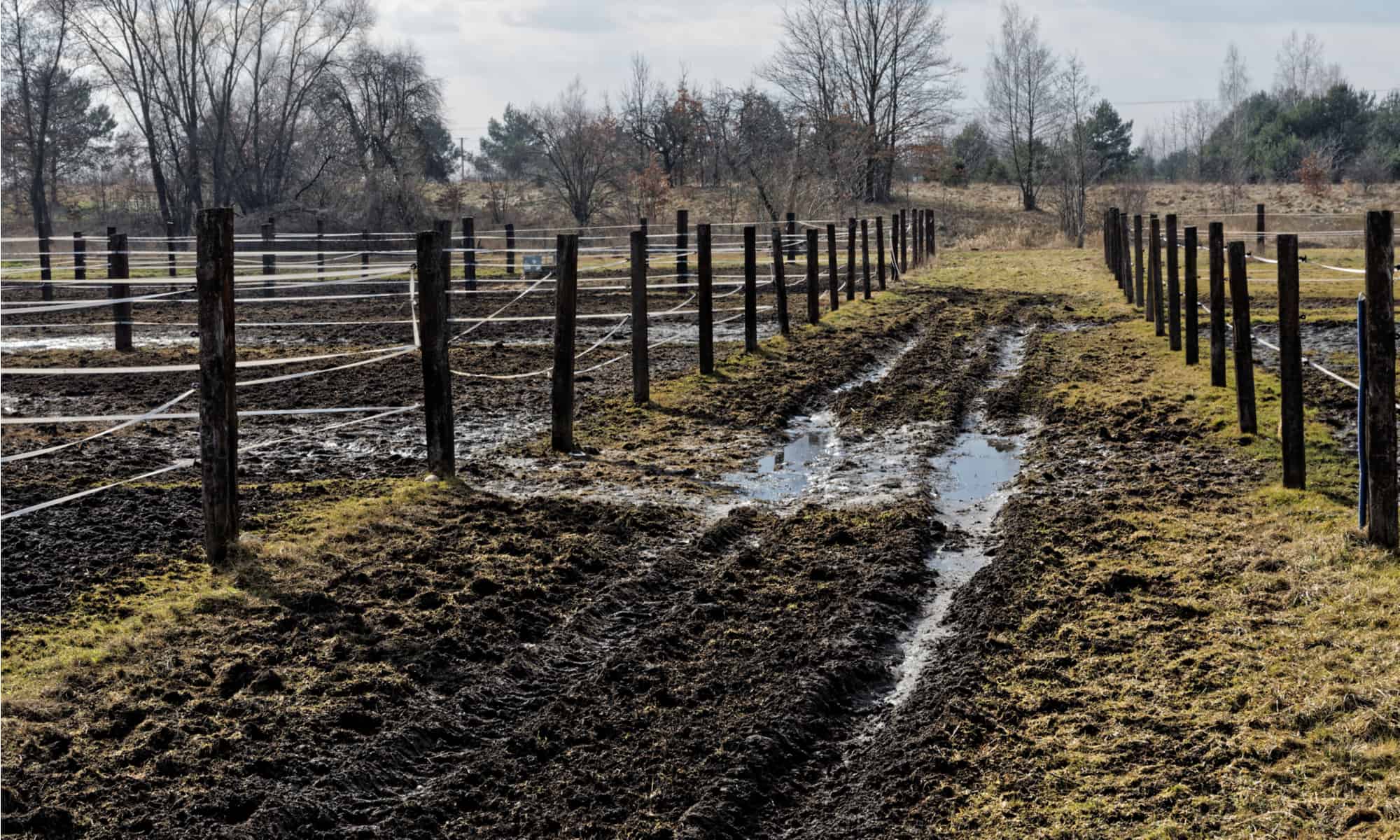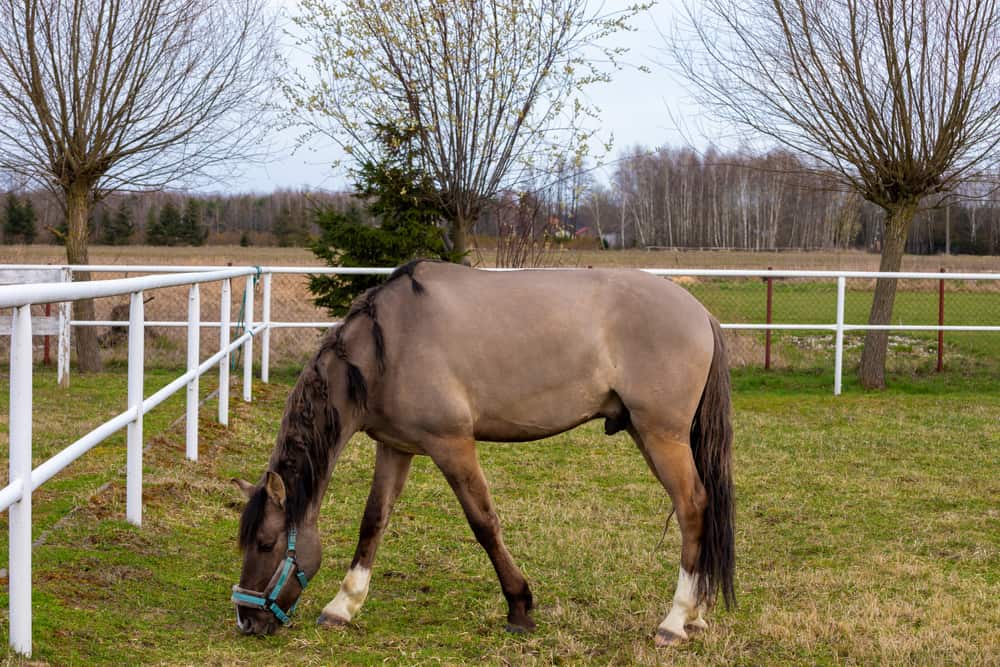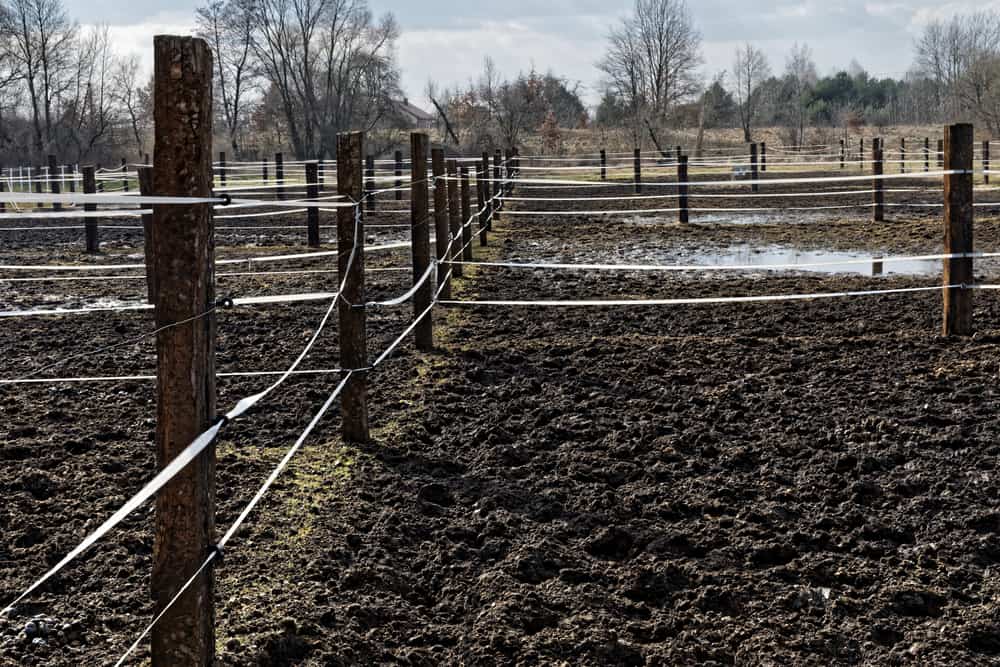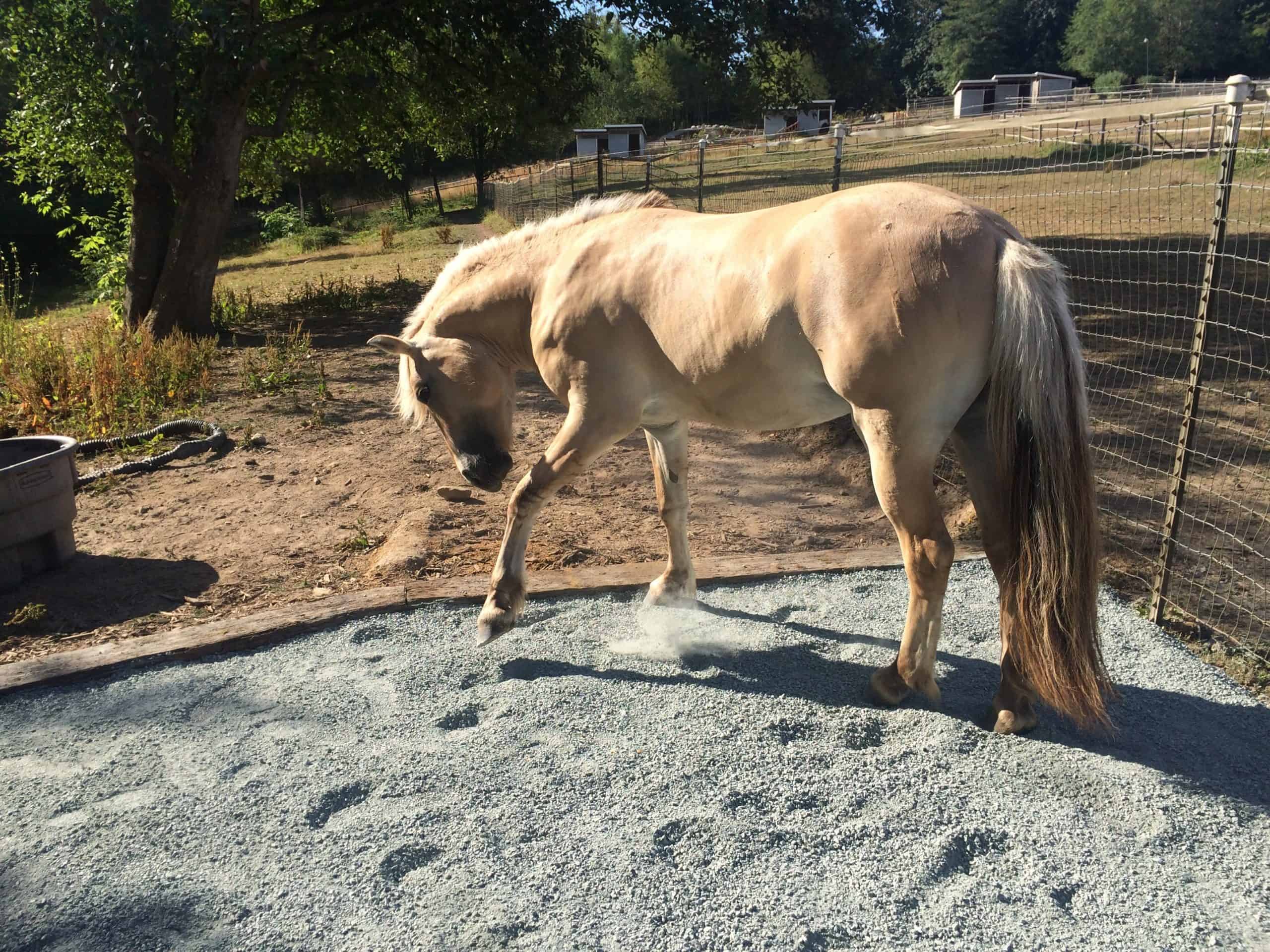As well as making your horse dirty, a muddy paddock can cause serious problems. Wet, muddy hooves and legs can harbor diseases. And at the very least, you’ll be getting covered in the stuff whenever you groom your horse!
So if you have a paddock that’s prone to getting boggy, we’re here to help. We’re going to share 6 tips to fix muddy horse paddock areas. And we’ll give you plenty of different options to get rid of the problem for good.
So step this way for everything you need to know!
1. If you can, situate your paddock carefully
If you’re lucky enough to be starting from scratch, careful planning can help avoid the worst problems with mud.
Choosing a paddock on high ground with good drainage will give the water somewhere to go. A gentle slope of between two and five per cent will ensure the water runs off the ground. And because there’ll be less moisture in the soil, it will be less prone to being churned by horses’ hooves.
If possible, have the boundary positioned before the slope flattens out. A flat area at the bottom will give the water somewhere to collect. And if that’s where your horses choose to stand, that can be a recipe for a muddy disaster!
So situate feeding areas, gates and sheds at the top. That will keep things more interesting for the horses away from the wettest part of the paddock.
2. Remember that buildings collect rainwater
It’s important to remember that any structures in your paddock will collect rainwater on their roofs. That should be funnelled to the ground via guttering and downpipes.
You may be surprised at just how much water can be involved. A roof measuring 20 by 50 feet will collect more than 26 gallons of water after an inch of rain.
And average annual rainfall in the contiguous states of the USA was just over 30 inches in 2020. That’s over 800 gallons of water falling on that roof over the year.
Think about where this water will go. It’s another good reason for positioning sheds at the top of a slope, where the water will quickly drain away.
Make sure guttering and downpipes are cleared regularly so that continue to do their jobs. And ensure they’re directing water away from the paddock. If they’re not, you can buy downpipe extenders to divert the flow.
If there are any buildings where downpipes are absent or blocked, try to resolve the issue as soon as possible. But if you need a temporary fix, you can dig a shallow trench parallel with the eaves.
Give it a gentle slope to direct the water away to a buffer. A clump of trees is ideal, as the roots will soak up the moisture.
Just make sure that your trench isn’t too deep. You don’t want to risk your horses stumbling in and hurting themselves.
3. Understand the problem
If you’re not starting with a blank sheet of paper, don’t despair. You can address problems with mud in an existing paddock too. The first step is to understand what you’re dealing with.
Start by working out where the moisture in the ground is coming from. A wet winter’s day is the perfect time to do this. Take a good look around the paddock and see where the water is collecting.
This won’t be the time of year when you’ll want to be out for hours creating permanent solutions. But you can put in place temporary fixes that will manage the issue until the weather improves.
The simplest of these is shallow trenches. Dig them where the water is flowing, directing it away to an area where it can be absorbed. Any areas of grass or tree growth are great for this.
A layer of pea gravel on top of the trench will help with drainage too. And don’t forget to dig the trench with a gentle slope so that the water doesn’t back up. And to keep it shallow enough that it doesn’t create a hazard for your horses.
Monitor how effectively your trenches work. If they’re doing a good job, you can turn them into permanent solutions, like French drains, when the weather improves.
4. Don’t make things worse
As well as taking steps to improve drainage, it’s important not to exacerbate the problem of mud. You can avoid that by managing grazing and clean-up.
If you have a grass paddock, over-grazing will make it especially vulnerable to becoming muddy. With fewer blades of grass there’ll be less organic matter to soak up the water. So try to rotate grazing between different paddocks to allow the grass time to recover.
If you have a single large grassy paddock, you can achieve the same effect by dividing it into different sections. That will allow you to give the pasture in one area a rest while the horses are using another spot.
The ground will become particularly muddy in any parts of the paddock where your horses often stand. So moving feeding stations regularly can also help.
And unfortunately, manure will exacerbate mud. Not only that, but the organic matter it contains means it’s a magnet for flies and other bugs that carry disease.
You may not want to pick up every bit of horse poop from your paddock! But cleaning out areas of gravel, or where there’s high traffic, will be a big help.
5. Add extra footing
Adding extra footing is a great way to help the ground stay firm when it rains. But make sure you address the drainage issues before you do this. Even the best footing won’t be able to resist mud if there’s too much water in the area.
Begin by planning where you’re going to position the footing. That’s likely to be where there’s high traffic from hooves or people. That means the areas around water troughs, feeding station locations and gates.
When it comes to the material for your footing you have a range of choices. Gravel, sand, wood products like hog-fuel, and plastic mesh like Lighthoof, can all work well. And some people also recommend using road fabric underneath the footing to help keep it in place.
6. Choose your footing wisely
The different types of footing on offer have different pros and cons. It’s worth being aware of these so you can consider what will work best in your specific circumstances.
Wood chips or hog-fuel are soft underfoot, and they can help compost your horse’s manure and urine. That will reduce odor levels. The downside with this material is that it breaks down relatively quickly.
And some farriers dislike it too. New hog-fuel is very acidic, so it can wear away the sole of the horse’s foot.
Gravel won’t help composting, but it will last much longer. If you’re in an area that gets heavy rainfall, it’s a good choice. Make sure it’s fine – no larger than 5/8ths of an inch – so that it won’t injure your horses’ feet.
If you’re using gravel, it will be more comfortable for your horses if you add a top layer of very fine material. That means a depth of between 2 and 3 inches of ¼-inch minus gravel. The “minus” here means each piece of gravel is no bigger than a quarter of an inch. It’s also known as “crusher dust”.
There are, however, different views on the efficacy of crusher dust. Some people have found it’s so fine that it compacts together in wet weather. But at least one farrier sees that as an advantage to horses’ foot health.
Sand is soft, and coarser grades are good for drainage. But it can get dusty when the weather is dry. And keep it away from areas where horses feed. If they ingest it, it can cause colic.
Lighthoof is a plastic mesh with fist sized cells that lock together. It helps hold soil in place, preventing it being washed away when it rains. And it also provides a good platform for other forms of footing like gravel or sand.
It doesn’t become brittle either, so you won’t have to worry about it injuring your horses if they uncover it.
One other thing to bear in mind is that different footings will behave differently, depending on what’s underneath them. Crusher dust, for example, will be more effective over rock or larger gravel than it will directly over mud. So consider adding different layers of footing to get the best results.
Time to say goodbye to muddy paddocks!
We hope you’ve enjoyed our top 6 tips to fix muddy paddock areas!
If you’re planning a brand new paddock, there’s lots of scope to minimize the potential for mud at the design stage. But if you already have a paddock with muddy areas, there are plenty of solutions too.
Start by taking a good look at the area and any buildings. That will help you identify where to dig trenches, position permanent drains, and add extra footing.
And good management of your paddock, by rotating feeding stations and cleaning up regularly, will minimize mud too.
Good luck – and we hope you and your horse are soon enjoying a mud-free paddock!











